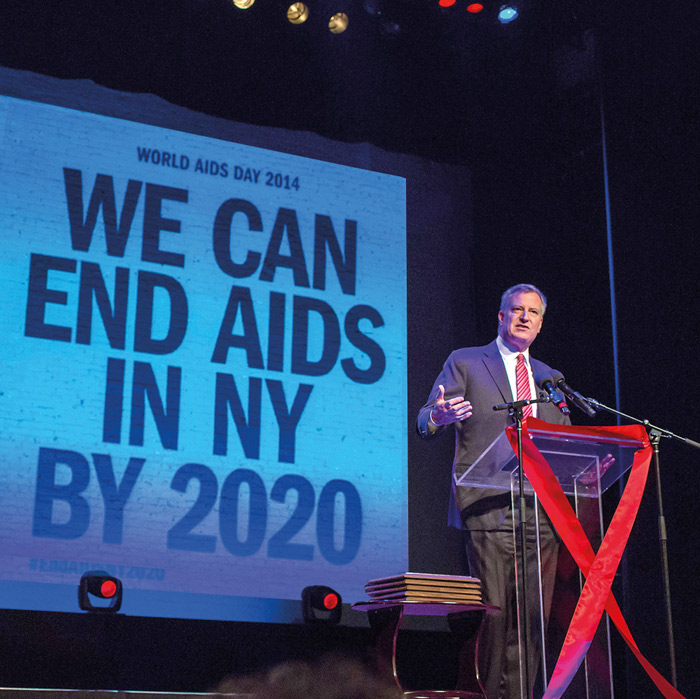Photo Courtesy of Ed Reed/Mayoral Photography Office
“We will not rest until we end the epidemic once and for all,” Mayor de Blasio said.
By Forum Staff
New York City has reached the UNAIDS 90-90-90 goals—90 percent of all people with HIV know their status; 90 percent of all people diagnosed with HIV are on treatment; and 90 percent of all people diagnosed with HIV who are on treatment are virally suppressed—two years ahead of schedule, Mayor Bill de Blasio announced Monday.
As of 2018 in the five boroughs, 93 percent of people with HIV have been diagnosed; 90 percent of people diagnosed with HIV are on treatment; and 92 percent of people on treatment are virally suppressed. And last month, the City Health Department released the 2018 HIV Surveillance Annual Report, which showed the number of people newly diagnosed with HIV in New York City in 2018 fell below 2,000 for the first time since annual HIV reporting began in 2001.
NYC Health Commissioner Oxiris Barbot, M.D., said Gotham “is charting a path to zero new diagnoses.”
The Big Apple is the first Fast-Track city in the U.S. to reach the 90-90-90 milestone. The Fast-Track Cities initiative is a global partnership of more than 300 cities and municipalities around the world working to achieve the aforementioned UNAIDS targets.
“Years of hard work and determination has put New York front and center in the global fight against HIV/AIDS,” de Blasio said. “With more New Yorkers receiving treatment than ever, the day of zero diagnoses is closer than ever—something many believed unthinkable not so long ago. We will not rest until we end the epidemic once and for all.”
On Sunday, World AIDS Day, Gov. Andrew Cuomo announced that HIV incidence—or the estimated number of new HIV infections—continue to fall to historically low levels. Additionally, data from 2018 shows 82 percent of newly diagnosed New Yorkers were connected with care within 30 days of diagnosis, Cuomo noted.
The new data indicate that the Empire State is on track to achieve the governor’s goal of “Ending the Epidemic” by the end of 2020. The “Ending the Epidemic” initiative was launched in 2014 to significantly reduce HIV infections by the end of next year and achieve the first-ever decrease in the number of people living with HIV in New York. As the governor noted, “Ending the Epidemic” does not mean the absolute elimination of HIV/AIDS, which would require a cure for those currently living with HIV/AIDS and a vaccine to prevent future transmission, but rather what public health officials call “bending the curve,” which occurs when the annual number of estimated new HIV infections is lower than the number of people with HIV who die in a given year.
“These record-low levels of estimated new HIV infections and other key metrics—including new data showing we are connecting people to care sooner—demonstrate once again that while our work is not done, we are making important progress toward bending the curve on an epidemic that has taken the lives of too many people for too long,” Cuomo added.

